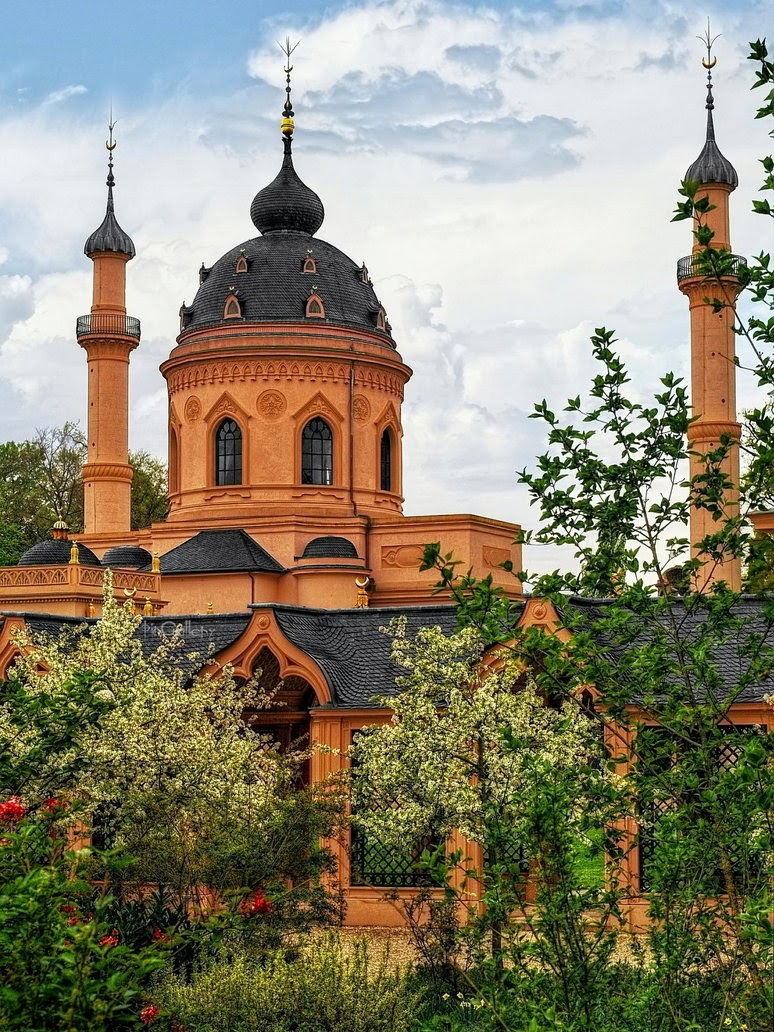 Schloss Schwetzingen, is a castle in the German state of Baden-Württemberg. Schwetzingen was the summer residence of the Electors Palatine Charles III Philip and Charles IV Theodore (of the House of Wittelsbach). It is situated in Schwetzingen, roughly equidistant from the electors' seats at Heidelberg and Mannheim, and is most notable for its spacious and ornate gardens.
Schloss Schwetzingen, is a castle in the German state of Baden-Württemberg. Schwetzingen was the summer residence of the Electors Palatine Charles III Philip and Charles IV Theodore (of the House of Wittelsbach). It is situated in Schwetzingen, roughly equidistant from the electors' seats at Heidelberg and Mannheim, and is most notable for its spacious and ornate gardens.Mavi Boncuk |
The mosque (German: "Moschee") in the gardens complex is the earliest[1] mosque-style building in Germany[2]. It was built in 1779-1791 by a French architect for the Prince Elector of the Palatinate. Built at a time when the "Turkish" style was fashionable in Germany, it was never intended for prayer but later served religious purposes at various times.
After many years of restoration, and at great expense, the mosque is fully restored and open to the public.
"In 1745, Frederick II of Prussia established a unit of Muslims in the Prussian army called the "Muslim Riders" and consisting mainly of Bosniaks, Albanians and Tatars. In 1760 a Bosniak corps was established with about 1,000 men. In 1798 a Muslim cemetery was established in Berlin. The cemetery, which moved in 1866, still exists today..." SOURCE
"....Thus the early appropriations of cultural forms from the East were based on synoptic views of the history of Islamic architecture From the second half of the eighteenth century onwards, the mosque, with its dome and minaret, was singled out as the stylistic/formal metonym of the Muslim 'other.' It became a leitmotif in what is known as 'exoticism' or turquerie in architecture. Mosque-like buildings, mostly based on the Turkish model—since the "Turk" itself was a synonym for the Muslim 'other'—transfigured into garden ornaments all over Europe...Examples of this transfiguration include the Turkish Mosque at Kew Gardens in London built in 1762, the Mosque at the Schloss Garten in Schwetzingen constructed in 1776, and the Mosque at the Armainvilliers, near Paris, designed in 1785. Needless to say none of these buildings were functional. Although Frederick the Great of Prussia went so far as to think about establishing a working mosque as part of his enlightenment project of religious tolerance, the foundation of such a mosque in Western Europe has its much more humble origins in the late nineteenth century.
With the dawn of industrialism in the early nineteenth century, however, these ornamental buildings were replaced with functional ones clad in freely mixed architectural idioms of the East for playful aesthetic reasons. Although continuing to resemble mosques with their domes and minarets, they functioned as bathhouses (such as those at Leeds or at Tsarskoye Selo in St. Petersburg c.1852), or as steam-driven pump stations (like the one built at Potsdam near Berlin c.1842), and even as a cigarette factory..."[3]
[1] The oldest real mosque in Germany was built in Berlin in 1923-25 by the Ahmadiyya Anjuman, an Islamic reform movement that originated from India. It is still in use.
[2] Article | Architecture and Migration: Germany
[3] Article | Identity-as-Form: The Mosque in the West | Nebahat Avcioglu Columbia University Institute for Scholars, Paris, France